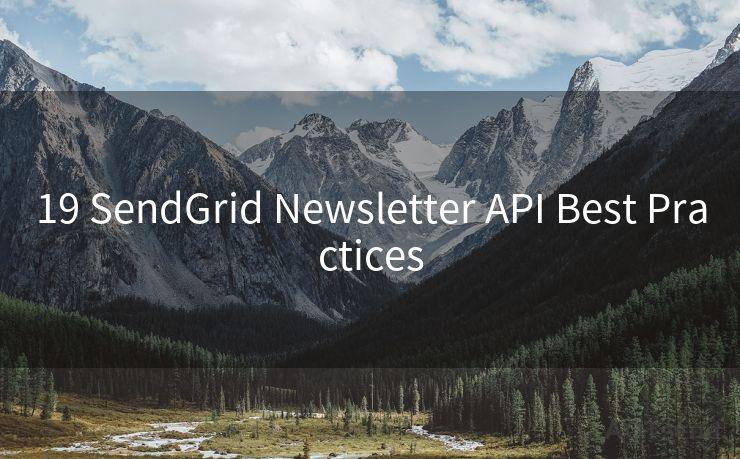19 SendGrid Newsletter API Best Practices




When it comes to email marketing, using the SendGrid Newsletter API effectively can make a significant difference in your campaign's success. To help you achieve the best results, here are 19 best practices for utilizing the SendGrid Newsletter API.
1. Understand the API Basics
Before diving into the best practices, it's essential to have a solid understanding of the SendGrid Newsletter API and its capabilities. Explore the documentation, understand the endpoints, and familiarize yourself with the various parameters and options available.
2. Authenticate Securely
Ensure that your API requests are securely authenticated. SendGrid provides multiple authentication methods, such as API keys. Use them to protect your account and data.
3. Maintain Clean and Updated Lists
Regularly update and clean your email lists to ensure they are accurate and up-to-date. This helps avoid bounce rates and improves the deliverability of your newsletters.
4. Personalize Your Content
Utilize the power of personalization in your newsletters. The SendGrid API allows you to insert dynamic content, making each email feel more tailored to the recipient.
5. Optimize for Mobile Devices
With the majority of emails being opened on mobile devices, it's crucial to ensure your newsletters are mobile-friendly. Use responsive templates that adapt to different screen sizes.
6. Test, Test, and Test Again
Before sending out your newsletter, conduct thorough testing. Send test emails to yourself and colleagues to check for formatting, links, and overall readability.
7. Monitor Your Metrics
Keep track of key metrics like open rates, click-through rates, and unsubscribes. The SendGrid API provides valuable insights to help you fine-tune your campaigns.
8. Handle Bounces and Unsubscribes Gracefully
Manage bounces and unsubscribe requests effectively. Use the API to remove invalid or uninterested email addresses from your lists promptly.
9. Comply with Email Regulations
Ensure your newsletters comply with email regulations, such as CAN-SPAM and GDPR. The SendGrid API helps you manage opt-ins, opt-outs, and other consent-related matters.
10. Segment Your Audience
Segment your audience based on interests, demographics, or purchase history. The API allows you to target specific groups for more relevant and effective newsletters.
11. Utilize A/B Testing
Experiment with A/B testing to see which subject lines, content, or designs perform better. The SendGrid API supports split testing, helping you optimize your campaigns.
12. Schedule Your Sends

Take advantage of the scheduling feature in the SendGrid API. Plan your newsletter sends at optimal times for maximum engagement.
13. Leverage Transactional and Marketing Emails
Combine transactional and marketing emails effectively. Use the API to send timely, relevant messages that complement your newsletter campaigns.
14. Integrate with Other Tools
Integrate the SendGrid API with your CRM, analytics tools, and other marketing platforms for a holistic view of your campaigns' performance.
15. Handle Deliverability Issues
Monitor and address deliverability issues promptly. The SendGrid API provides tools and insights to help you improve email deliverability rates.
16. Use Engaging Content
Create engaging content that resonates with your audience. Use stories, visuals, and interactive elements to keep readers interested.
🔔🔔🔔
【AOTsend Email API】:AOTsend is a Managed Email Service for sending transactional emails. Support Email Types: reminders, authentication, confirmations, notifications, verification codes, invoices, password resets, account activations, billing statements, two-factor authentication (2FA), and one-time passwords (OTP) emails, etc. $0.28 per 1000 Emails. 99% Delivery, 98% Inbox Rate.
You might be interested in:
Why did we start the AOTsend project, Brand Story?
What is a Managed Email API, How it Works?
Best 25+ Email Marketing Platforms (Authority,Keywords&Traffic Comparison)
Best 24+ Email Marketing Service (Price, Pros&Cons Comparison)
Email APIs vs SMTP: How they Works, Any Difference?
17. Maintain a Consistent Cadence
Establish a consistent sending cadence for your newsletters. The SendGrid API helps you automate and schedule sends, ensuring timely delivery.
18. Leverage Automation
Automate your newsletter workflow using the SendGrid API. From list management to email sends, automation saves time and improves efficiency.
19. Stay Updated with SendGrid
Keep up with SendGrid's updates and new features. Their team constantly improves the platform, providing more capabilities to enhance your newsletter campaigns.
By following these 19 best practices for the SendGrid Newsletter API, you can significantly improve the impact and effectiveness of your email marketing efforts. Stay tuned to SendGrid's latest developments and continue optimizing your strategies for even better results.




Scan the QR code to access on your mobile device.
Copyright notice: This article is published by AotSend. Reproduction requires attribution.
Article Link:https://www.mailwot.com/p2174.html



